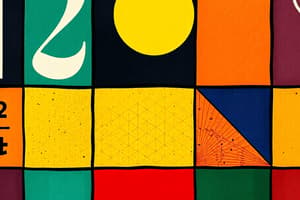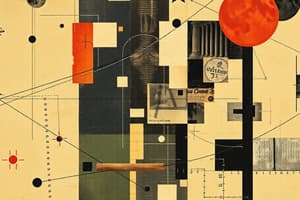Podcast
Questions and Answers
A store is selling apples at $1.50 each and bananas at $0.75 each. If a customer buys 3 apples and 4 bananas, what is the total cost?
A store is selling apples at $1.50 each and bananas at $0.75 each. If a customer buys 3 apples and 4 bananas, what is the total cost?
- $8.00
- $6.50
- $7.50 (correct)
- $7.00
Solve for $x$: $3x + 7 = 22$
Solve for $x$: $3x + 7 = 22$
- x = 3
- x = 7
- x = 5 (correct)
- x = 9
What is the area of a triangle with a base of 10 cm and a height of 8 cm?
What is the area of a triangle with a base of 10 cm and a height of 8 cm?
- 30 cm²
- 80 cm²
- 100 cm²
- 40 cm² (correct)
A car travels 240 miles in 4 hours. What is its average speed in miles per hour?
A car travels 240 miles in 4 hours. What is its average speed in miles per hour?
If a shirt is on sale for 20% off and its original price is $25, what is the sale price?
If a shirt is on sale for 20% off and its original price is $25, what is the sale price?
What is the value of $2^5$?
What is the value of $2^5$?
Solve for $y$: $2(y - 3) = 10$
Solve for $y$: $2(y - 3) = 10$
What is the perimeter of a rectangle with a length of 12 cm and a width of 7 cm?
What is the perimeter of a rectangle with a length of 12 cm and a width of 7 cm?
If a bag contains 5 red marbles and 3 blue marbles, what is the probability of picking a red marble at random?
If a bag contains 5 red marbles and 3 blue marbles, what is the probability of picking a red marble at random?
What is the value of $15 \div 3 + 4 \times 2 - 1$?
What is the value of $15 \div 3 + 4 \times 2 - 1$?
Flashcards
What is mathematics?
What is mathematics?
The study of numbers, quantities, shapes, and their relationships using symbols and rules.
Study Notes
- Mathematics is the abstract science of number, quantity, and space
- It may be studied in its own right (pure mathematics), or as it is applied to other disciplines such as physics and engineering (applied mathematics)
Arithmetic
- Arithmetic involves studying numbers and the basic operations that can be performed on them
- Basic operations include addition, subtraction, multiplication, and division
- Whole numbers are non-negative integers (0, 1, 2, 3...)
- Integers include all whole numbers as well as their negative counterparts (...-3, -2, -1, 0, 1, 2, 3...)
- Rational numbers can be expressed as a fraction p/q, where p and q are integers and q is not zero
- Irrational numbers cannot be expressed as a fraction, examples include √2 and π
Algebra
- Algebra involves generalizing arithmetic operations and studying mathematical relationships using symbols
- Variables are symbols (usually letters) that represent unknown or changeable quantities
- Equations are mathematical statements showing the equality of two expressions
- Solving an equation involves finding the value(s) of the variable(s) that make the equation true
- Linear equations are equations where the highest power of the variable is 1
- Quadratic equations are equations where the highest power of the variable is 2, a standard form is ax² + bx + c = 0
- Functions are relationships that map each input value to a unique output value
- The graph of a function is a visual representation of this relationship
- Common functions: linear, quadratic, exponential, logarithmic, and trigonometric
Geometry
- Geometry deals with shapes, sizes, relative positions of figures, and the properties of space
- Euclidean geometry studies shapes in a two-dimensional plane and three-dimensional space based on axioms and theorems
- Points, lines, and planes are fundamental undefined objects in Euclidean geometry
- Angles are formed by two rays sharing a common endpoint (vertex), measured in degrees or radians
- Triangles are three-sided polygons, categorized by their angles (acute, obtuse, right) and sides (equilateral, isosceles, scalene)
- Circles are sets of points equidistant from a center point
- Coordinate geometry uses a coordinate system to represent geometric shapes and solve geometric problems algebraically
- Transformations involve changing the position, size, or orientation of a shape, examples include translation, rotation, reflection, and scaling
- Trigonometry is the study of relationships between angles and sides of triangles, particularly right triangles
- Trigonometric functions (sine, cosine, tangent) relate an angle to ratios of sides in a right triangle
Calculus
- Calculus studies continuous change, encompassing two main branches: differential calculus and integral calculus
- Differential calculus deals with rates of change and slopes of curves
- Derivatives measure the instantaneous rate of change of a function
- Integral calculus deals with accumulation of quantities and areas under curves
- Integrals are the reverse process of differentiation, used to find areas, volumes, and other accumulated quantities
- Limits are the values that a function approaches as the input approaches some value
- Continuity describes functions that have no abrupt changes or breaks in their graphs
- Applications includes optimization problems, physics, engineering, economics, and statistics
Statistics and Probability
- Statistics involves collecting, analyzing, interpreting, and presenting data
- Descriptive statistics summarize and describe the main features of a dataset, including measures of central tendency (mean, median, mode) and measures of dispersion (variance, standard deviation)
- Inferential statistics uses sample data to make inferences and generalizations about a larger population
- Probability is the measure of the likelihood that an event will occur
- Probability ranges from 0 (impossible) to 1 (certain)
- Probability distributions describe the probabilities of different outcomes in a random experiment
- Common distributions include normal, binomial, and Poisson
- Statistical hypothesis testing involves using data to assess the validity of a hypothesis about a population
- Regression analysis examines the relationship between variables to make predictions
Discrete Mathematics
- Discrete mathematics studies mathematical structures that are fundamentally discrete rather than continuous
- Logic deals with reasoning and argumentation, including propositional logic and predicate logic
- Set theory studies sets, which are collections of objects
- Relations and functions formalize relationships between sets
- Combinatorics involves counting and arranging objects, including permutations and combinations
- Graph theory studies graphs, which are structures consisting of vertices and edges connecting pairs of vertices
- Applications includes computer science, cryptography, and operations research
Mathematical Analysis
- Mathematical analysis provides a rigorous foundation for calculus and relates areas of mathematics
- Real analysis studies the real number system, sequences, series, limits, continuity, and differentiability of real-valued functions
- Complex analysis extends concepts of calculus to complex numbers
- Functional analysis studies vector spaces and linear operators
- Topology studies properties of spaces that are preserved under continuous deformations
Studying That Suits You
Use AI to generate personalized quizzes and flashcards to suit your learning preferences.




